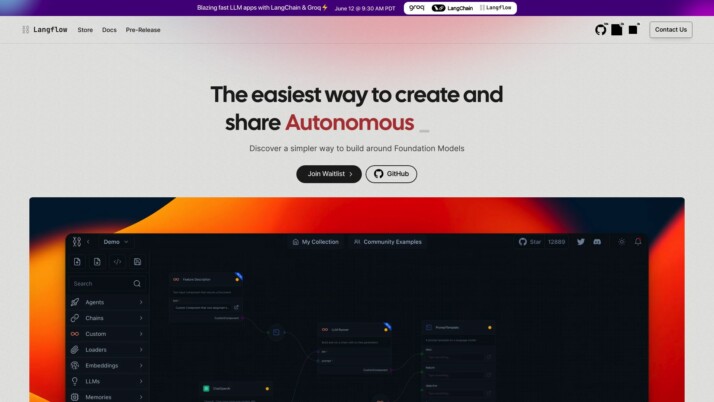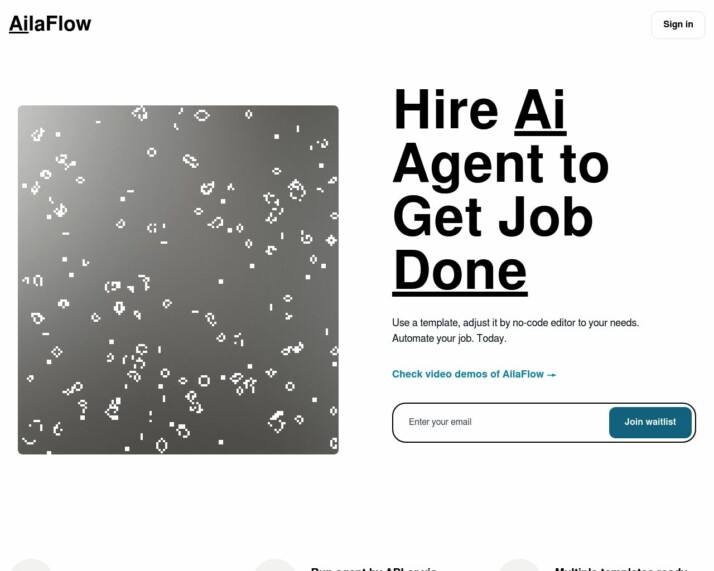Langflow vs. AilaFlow: AI Agent Development Platforms Compared
AI agent development platforms have transformed the landscape of software creation, enabling both technical and non-technical users to harness the power of artificial intelligence. This comparison explores Langflow vs. AilaFlow, and SmythOS, three platforms at the forefront of this revolution.
We’ll delve into their key features, strengths, and limitations to help you choose the best solution for your AI development needs. Whether you’re a seasoned developer seeking advanced capabilities or a business user looking for no-code simplicity, this analysis will guide you through the unique offerings of each platform, highlighting how they address the growing demand for accessible yet powerful AI tools.
Langflow Overview
Langflow empowers users to create AI-driven applications through an intuitive, low-code platform. This open-source tool simplifies the process of building complex AI workflows, making it accessible to developers and non-technical users alike.


Langflow’s visual interface allows users to construct AI flows by dragging and connecting pre-built components. These components encompass a wide range of AI capabilities, including large language models, memory systems, and specialized agents. This approach enables rapid prototyping and experimentation, accelerating the development of AI solutions for various use cases.
Langflow’s visual interface allows users to construct AI flows by dragging and connecting pre-built components … enabling rapid prototyping and experimentation.
The platform supports both local installations and cloud deployments, offering flexibility for different development and production environments. Langflow’s integration with HuggingFace Spaces further enhances its accessibility, allowing users to run the platform without local setup.
Langflow prioritizes security and customization. It provides robust authentication mechanisms and allows for the creation of custom components using Python scripts. This combination of security features and extensibility makes Langflow suitable for both individual developers and enterprise teams looking to leverage AI technologies.
While Langflow offers significant advantages in terms of ease of use and rapid development, it may have limitations for highly specific or large-scale deployments compared to more traditional, code-intensive approaches. Users should consider their specific requirements and scalability needs when evaluating Langflow for their projects.
AilaFlow Overview
AilaFlow offers a no-code platform for building AI agents, focusing on accessibility and versatility. The platform’s core component, the Sequential Workflow Designer, enables users to create AI agents without coding experience. This web-based tool, written in TypeScript and using SVG for rendering, supports various applications from graphical programming to sequence diagram editing.
AilaFlow emphasizes ease of use and broad compatibility. The platform works with modern browsers and mobile devices, storing workflow definitions as JSON. It integrates seamlessly with popular frameworks like Angular, React, and Svelte, showcasing its adaptability across different development environments.
AilaFlow offers a no-code platform for building AI agents, focusing on accessibility and versatility. The platform’s core component … enables users to create AI agents without coding experience.


Customization stands out as a key feature of AilaFlow. Users can adjust themes, including light and dark modes, and configure various aspects of the platform to suit their preferences. The toolset includes features like badges, editing restrictions, and undo/redo operations, enhancing the user experience and workflow efficiency.
Customization stands out as a key feature of AilaFlow. Users can adjust themes … and configure various aspects of the platform to suit their preferences.
AilaFlow’s vision centers on democratizing AI agent creation, making it accessible to a wider audience regardless of technical background. This approach aligns with the growing trend of no-code solutions in the tech industry, potentially opening up AI development to new sectors and user groups.
AilaFlow’s vision centers on democratizing AI agent creation, making it accessible to a wider audience regardless of technical background.
However, the platform’s capabilities in areas like multimodal processing, advanced problem-solving, and integration with external APIs remain unclear from the available information. Additionally, details about pricing models, enterprise-level features, and scalability are not readily apparent, which could be crucial factors for businesses considering long-term adoption.
Feature Comparison
Langflow and AilaFlow offer contrasting approaches to AI agent development, with significant feature gaps in core components and security. Langflow provides a more comprehensive set of AI agent capabilities, including support for various agent types like CSVAgent, JSONAgent, and SQLAgent. It also offers robust memory components such as ConversationBufferMemory and ConversationEntityMemory, enabling contextual conversations. In contrast, AilaFlow’s AI agent capabilities are less defined, focusing more on its Sequential Workflow Designer for visual programming.
Security features highlight another key difference. Langflow implements data encryption, uses environment variables for sensitive data, and supports OAuth for API authentication. AilaFlow’s security features are not explicitly detailed, potentially indicating a gap in this critical area. This disparity extends to deployment options, where Langflow offers versatility in deploying agents as APIs, webhooks, and site chats, while AilaFlow’s deployment capabilities are less clear.
Core components also reveal significant differences. Langflow integrates with foundation models and Hugging Face, supports various APIs, and includes components for classification and logic operations. AilaFlow, while offering a customizable workflow designer, does not explicitly mention support for these advanced AI functionalities. This gap suggests that Langflow may be better suited for more complex AI development tasks, while AilaFlow might appeal to users seeking a simpler, visually-oriented approach to workflow design.
Feature Comparison Table
| Langflow | AilaFlow | SmythOS | |
|---|---|---|---|
| CORE FEATURES | |||
| Problem-Solving Capabilities | ❌ | ✅ | ✅ |
| Work as Team | ❌ | ✅ | ✅ |
| Bulk Work | ❌ | ✅ | ✅ |
| Agent Work Scheduler | ❌ | ✅ | ✅ |
| SECURITY | |||
| Constrained Alignment | ✅ | ❌ | ✅ |
| Data Encryption | ❌ | ✅ | ✅ |
| IP Control | ❌ | ❌ | ✅ |
| COMPONENTS | |||
| Foundation AIs | ❌ | ✅ | ✅ |
| All other APIs, RPA | ❌ | ✅ | ✅ |
| Data Lakes | ✅ | ❌ | ✅ |
| DEPLOYMENT OPTIONS (EMBODIMENTS) | |||
| Deploy as API | ❌ | ✅ | ✅ |
| Staging Domains | ✅ | ❌ | ✅ |
| Production Domains | ❌ | ❌ | ✅ |
| API Authentication (OAuth + Key) | ❌ | ✅ | ✅ |
| Deploy as Site Chat | ❌ | ✅ | ✅ |
| Deploy as GPT | ❌ | ✅ | ✅ |
| DATA LAKE SUPPORT | |||
| Hosted Vector Database | ✅ | ❌ | ✅ |
| Sitemap Crawler | ❌ | ❌ | ✅ |
| YouTube Transcript Crawler | ❌ | ❌ | ✅ |
| URL Crawler | ❌ | ✅ | ✅ |
| PDF Support | ❌ | ✅ | ✅ |
Best Alternative to Langflow and AilaFlow
SmythOS stands out as the superior alternative to Langflow and AilaFlow for AI agent development. Our platform combines powerful features with unmatched ease of use, making it the ideal choice for businesses and developers seeking to harness the full potential of AI automation.
We offer a comprehensive suite of tools that surpass the capabilities of both Langflow and AilaFlow. Our drag-and-drop interface simplifies the creation of complex AI workflows, allowing users to build sophisticated agents without extensive coding knowledge. This visual approach to AI development democratizes the technology, empowering users across various skill levels to innovate and implement AI solutions.
SmythOS provides a robust set of pre-built API integrations and supports a wide array of AI models from leading providers. This extensive ecosystem enables seamless connection to various data sources, APIs, and AI functionalities…
Unlike Langflow and AilaFlow, SmythOS provides a robust set of pre-built API integrations and supports a wide array of AI models from leading providers. This extensive ecosystem enables seamless connection to various data sources, APIs, and AI functionalities, significantly reducing development time and expanding the potential applications of your AI agents.
Our platform excels in multi-agent orchestration, a feature that sets us apart from competitors. SmythOS allows teams of AI agents to collaborate on complex tasks, enhancing efficiency and scalability in ways that Langflow and AilaFlow cannot match. This capability is particularly valuable for enterprises tackling intricate, multi-faceted challenges that require coordinated AI efforts.
We also prioritize security and scalability, addressing critical concerns that may be overlooked by other platforms. SmythOS implements advanced data encryption, OAuth support, and IP control features, ensuring that your AI deployments remain secure and compliant with industry standards. Our scalable infrastructure allows for seamless growth, supporting everything from small-scale prototypes to large-scale, enterprise-level deployments with ease.
Conclusion
Langflow and AilaFlow offer unique approaches to AI agent development, each with distinct strengths. Langflow’s comprehensive AI capabilities and robust security features make it a strong choice for users seeking advanced functionality. AilaFlow’s focus on visual programming and customization appeals to those prioritizing ease of use and workflow design.
However, SmythOS emerges as the superior option, combining the best of both worlds and offering additional advantages. Our platform provides an intuitive drag-and-drop interface similar to AilaFlow, while matching and exceeding Langflow’s AI capabilities. SmythOS supports a vast array of AI models, including those from OpenAI, Anthropic, and Hugging Face, enabling users to create sophisticated AI workflows without extensive coding.
What truly sets SmythOS apart is its unparalleled integration ecosystem, with over 300,000 pre-built API integrations. This extensive library allows users to connect their AI agents to virtually any tool or service, streamlining complex workflows across various business functions. Additionally, our “Create Once, Deploy Anywhere” approach offers unmatched flexibility, enabling users to deploy their AI agents across multiple platforms with ease.
For those ready to experience the future of AI development, we invite you to explore our diverse range of AI-powered agent templates. These templates cover multiple business categories and are designed to jumpstart your AI journey. To get started with SmythOS and unlock its full potential, create a free account today. With our risk-free trial offering unlimited agents and a 30-day money-back guarantee, you can confidently begin building and deploying AI agents that will revolutionize your workflow.
Last updated:
Disclaimer: The information presented in this article is for general informational purposes only and is provided as is. While we strive to keep the content up-to-date and accurate, we make no representations or warranties of any kind, express or implied, about the completeness, accuracy, reliability, suitability, or availability of the information contained in this article.
Any reliance you place on such information is strictly at your own risk. We reserve the right to make additions, deletions, or modifications to the contents of this article at any time without prior notice.
In no event will we be liable for any loss or damage including without limitation, indirect or consequential loss or damage, or any loss or damage whatsoever arising from loss of data, profits, or any other loss not specified herein arising out of, or in connection with, the use of this article.
Despite our best efforts, this article may contain oversights, errors, or omissions. If you notice any inaccuracies or have concerns about the content, please report them through our content feedback form. Your input helps us maintain the quality and reliability of our information.
